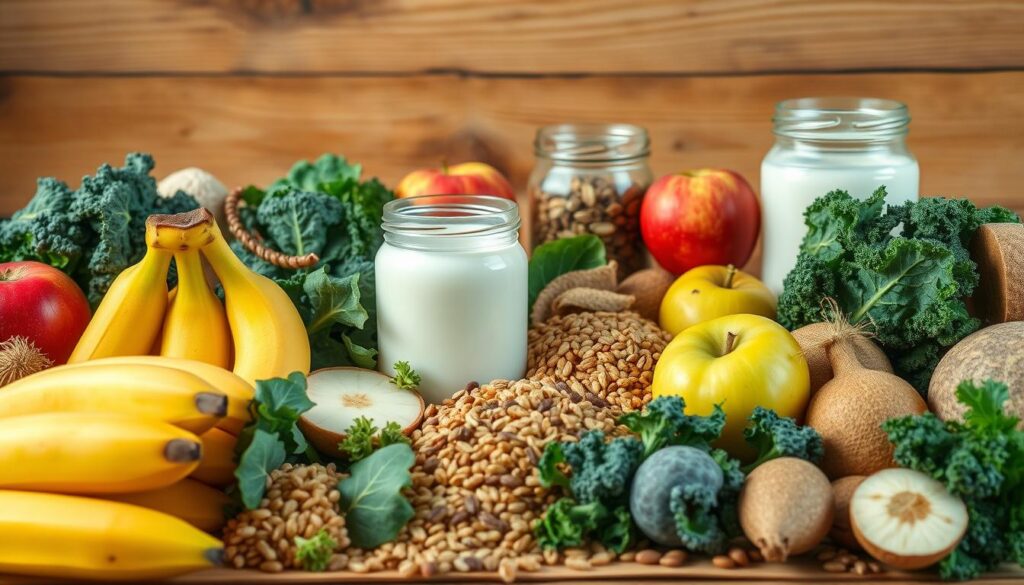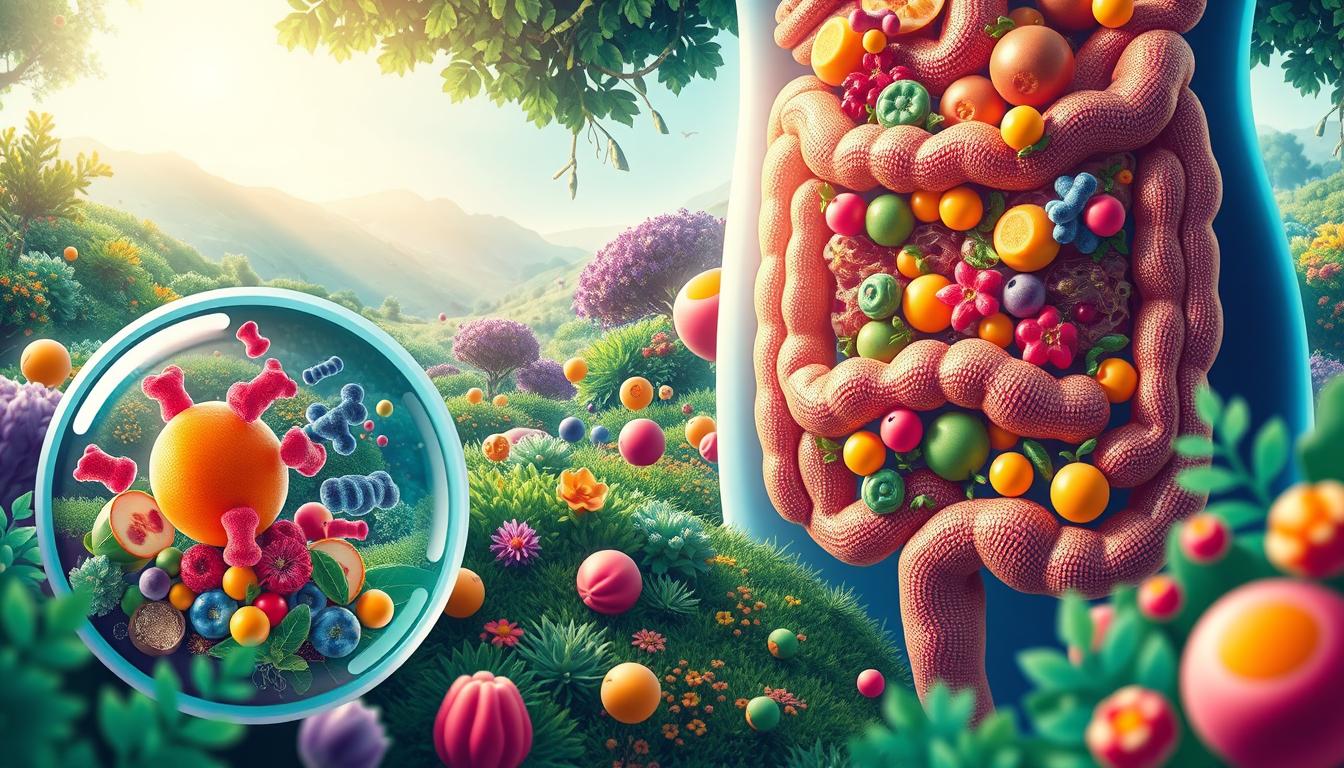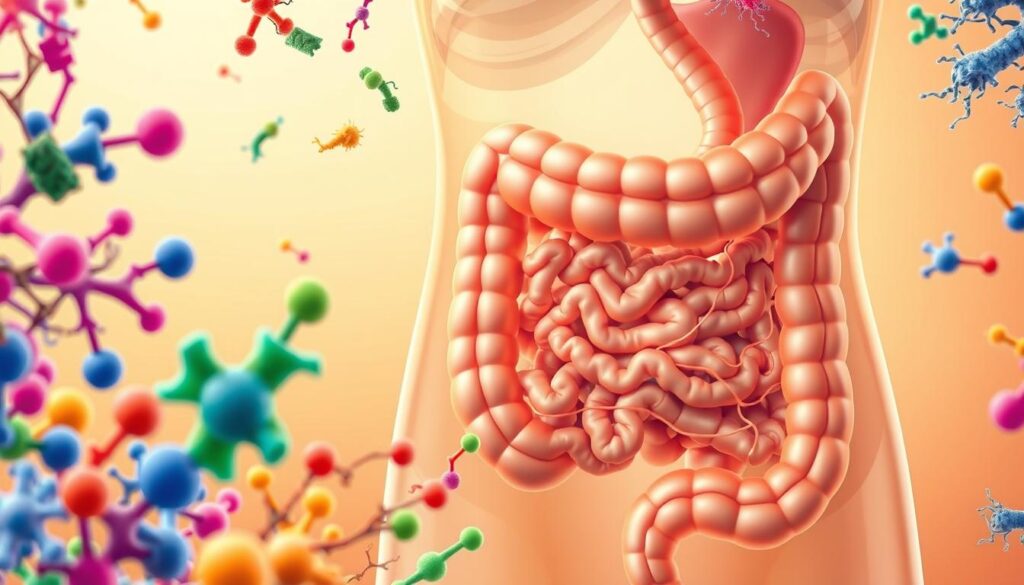Are you aware that your gut health plays a crucial role in your overall well-being? The balance of good bacteria in your gut is essential for a healthy digestive system and a strong immune system.
Maintaining a healthy microbiome is vital, and this is where probiotics and prebiotics come into play. Probiotics are the beneficial bacteria that help keep your gut healthy, while prebiotics are the food sources that help these bacteria thrive.
Key Takeaways
Table of Contents
- Probiotics and prebiotics work together to support gut health.
- A healthy microbiome is crucial for overall wellness.
- Probiotics help maintain a balanced digestive system.
- Prebiotics are essential for feeding beneficial bacteria.
- A strong immune system is linked to a healthy gut.
Understanding the Gut Microbiome
The gut microbiome is a complex ecosystem that plays a crucial role in our overall health and wellness. It consists of trillions of microorganisms, including bacteria, viruses, and fungi, that live in the gastrointestinal tract.
What Makes Up Your Gut Microbiome
The composition of the gut microbiome is influenced by various factors, including diet, lifestyle, and environmental exposures. A diverse and balanced gut microbiome is characterized by a wide variety of beneficial bacteria, such as Lactobacillus and Bifidobacterium, which are essential for maintaining a healthy gut.
Why Gut Health Matters for Overall Wellness
Gut health is closely linked to overall wellness, as an imbalance in the gut microbiome, also known as dysbiosis, can lead to various health issues, including digestive disorders, obesity, and even mental health problems. Maintaining a healthy balance of gut bacteria through a balanced diet and lifestyle is crucial for overall health.
Key factors that influence gut health include dietary choices, stress levels, and the use of antibiotics. By understanding the importance of the gut microbiome and taking steps to maintain its balance, individuals can promote overall wellness and reduce the risk of various health problems.
The Role of Probiotics and Prebiotics in Gut Health
Understanding the roles of probiotics and prebiotics is key to appreciating their impact on gut health. These two components work together to create a balanced gut microbiome.
Defining Probiotics: The Beneficial Bacteria
Probiotics are live, beneficial bacteria that are introduced into the gut to enhance its microbial balance. They are available in fermented foods and dietary supplements. Some common probiotic strains include Lactobacillus and Bifidobacterium, which are known for their health benefits.
Defining Prebiotics: Food for Good Bacteria
Prebiotics are non-digestible fibers that serve as food for the beneficial bacteria already present in the gut. They help in the proliferation of these good bacteria, thereby supporting gut health. Common prebiotic sources include asparagus, bananas, and onions.
How They Work Together: The Synbiotic Relationship
When probiotics and prebiotics are combined, they form a synbiotic relationship that enhances their individual benefits. This synergy promotes a healthy gut microbiome by improving the survival rate of beneficial bacteria and stimulating their activity.
The combined effect of probiotics and prebiotics can lead to improved digestive health, a boosted immune system, and even mental health benefits through the gut-brain axis.
Benefits of a Balanced Gut Microbiome
The benefits of a balanced gut microbiome are multifaceted and far-reaching, impacting various aspects of our health. A well-balanced gut microbiome is essential for maintaining overall well-being.
Digestive Health Improvements
A balanced gut microbiome leads to improved digestive health, reducing symptoms of bloating, gas, and irregular bowel movements. It enhances nutrient absorption and supports the integrity of the gut lining.
Immune System Support
The gut microbiome plays a crucial role in immune system support. A healthy balance of gut bacteria helps in the production of antibodies and activates immune cells, protecting against infections.
Mental Health Connections: The Gut-Brain Axis
There is a significant connection between the gut microbiome and mental health through the gut-brain axis. Research suggests that a balanced gut microbiome can influence mood and reduce symptoms of anxiety and depression.
Other Health Benefits
- Reduced inflammation
- Improved metabolic health
- Enhanced skin health
As highlighted by a study, a balanced gut microbiome can lead to overall health improvements, including reduced inflammation and better metabolic health (
“A healthy gut microbiome is associated with reduced inflammation and improved metabolic function.”
Identifying Signs of Poor Gut Health
Poor gut health can manifest in various ways, and being aware of the signs is essential for taking corrective action. A healthy gut microbiome is crucial for overall well-being, influencing not just digestive health but also immune function and mental clarity.
Common Digestive Symptoms
Digestive issues are often the first indicators of poor gut health. Common symptoms include bloating, gas, abdominal pain, diarrhea, and constipation. As noted by health experts, “Gut health is closely linked to overall health, and digestive symptoms can be a warning sign of imbalance.”

Non-Digestive Signs of Gut Imbalance
Gut imbalance can also manifest in non-digestive ways, such as fatigue, skin issues, and mood disturbances. The gut-brain axis is a complex network that links the gut microbiome to mental health, highlighting the importance of gut health for overall wellness.
When to Consult a Healthcare Provider
If you’re experiencing persistent or severe symptoms, it’s crucial to consult a healthcare provider. They can help determine the underlying cause of your symptoms and recommend appropriate treatments to restore gut balance.
Top Food Sources of Probiotics
Probiotic-rich foods are essential for maintaining a healthy gut microbiome. These foods contain live bacteria that can help populate your gut with beneficial microbes, supporting overall health.
Fermented Dairy Products
Fermented dairy products are among the richest sources of probiotics. Yogurt is one of the most well-known probiotic foods, containing strains like Lactobacillus acidophilus and Bifidobacterium bifidum. Other fermented dairy products include kefir and certain types of cheese.
Non-Dairy Fermented Foods
For those who are lactose intolerant or prefer non-dairy options, there are plenty of alternatives. Sauerkraut, kimchi, and miso are examples of fermented foods that are rich in probiotics. These foods not only support gut health but also add flavor to your meals.
Common Probiotic Strains and Their Benefits
Different probiotic strains offer various health benefits. For instance, Lactobacillus strains can aid digestion, while Bifidobacterium strains support immune function. Understanding the specific benefits of each strain can help you choose the right probiotic foods for your needs.
Tips for Incorporating Probiotic Foods Daily
To reap the benefits of probiotics, incorporate them into your daily diet. Start your day with probiotic-rich yogurt or kefir, add sauerkraut to your salads, or use miso in soups. Experimenting with different recipes can make it easy and enjoyable to consume probiotic foods regularly.
- Begin with small portions to allow your gut to adjust.
- Mix probiotic foods with other nutrient-rich foods for balanced meals.
- Keep a variety of probiotic foods in your diet to support diverse gut microbiota.
Best Prebiotic Food Sources
Prebiotics are non-digestible fibers that help feed the good bacteria in your gut, promoting a balanced microbiome. Incorporating these foods into your diet can have a significant impact on your overall gut health.
Fiber-Rich Fruits and Vegetables
Fiber-rich fruits and vegetables are among the best sources of prebiotics. Some examples include bananas, apples, and onions. These foods are not only rich in prebiotics but also provide essential vitamins and minerals.

Whole Grains and Legumes
Whole grains like oats, barley, and whole wheat, along with legumes such as beans and lentils, are rich in prebiotic fibers. These foods help in maintaining a healthy gut by supporting the growth of beneficial bacteria.
Creating Prebiotic-Rich Meal Plans
To maximize the benefits of prebiotics, it’s essential to create meal plans that incorporate a variety of prebiotic-rich foods. Here’s a sample table to help you get started:
| Meal | Foods | Prebiotic Benefits |
|---|---|---|
| Breakfast | Oatmeal with banana and apple | Rich in fiber, supports gut health |
| Lunch | Lentil soup with whole grain bread | High in prebiotic fibers, promotes beneficial bacteria |
| Dinner | Grilled chicken with roasted onions and beans | Supports gut health with fiber-rich vegetables and legumes |
By incorporating these prebiotic-rich foods into your meal plans, you can take a significant step towards improving your gut health.
Creating Your Personal Gut Health Plan
Developing a personalized gut health plan is crucial for achieving optimal digestive wellness. This involves a multi-step process that helps you understand your current gut health status and make informed decisions to improve it.
Step 1: Assessing Your Current Gut Health
Begin by evaluating your current digestive health. Keep a food diary to track what you eat and any symptoms you experience. This will help identify potential food sensitivities and patterns.
- Record your daily food intake
- Note any digestive symptoms
- Identify patterns and correlations
Step 2: Setting Realistic Goals
Set achievable goals for improving your gut health. This could include reducing symptoms of bloating, improving bowel regularity, or enhancing overall energy levels.
- Define your gut health objectives
- Establish a timeline for achieving these goals
Step 3: Incorporating Probiotics and Prebiotics Gradually
Gradually introduce probiotics and prebiotics into your diet. Start with small amounts and monitor your body’s response.
Regularly assess your progress by continuing to keep a food and symptom diary. Adjust your plan as needed based on your observations.
Common Challenges and How to Overcome Them
Be aware of potential challenges such as initial digestive discomfort when introducing probiotics or prebiotics. To overcome these, start with low doses and gradually increase them.
- Stay hydrated to help your body adjust
- Consult a healthcare provider if discomfort persists
By following these steps and being patient with your progress, you can create an effective gut health plan tailored to your needs.
Conclusion: Building a Sustainable Gut-Friendly Lifestyle
Maintaining a healthy gut microbiome is a long-term commitment that requires a balanced approach to diet and lifestyle. By incorporating probiotics and prebiotics into your daily routine, you can support the growth of beneficial bacteria and promote overall wellness.
A gut-friendly lifestyle is not just about making temporary changes; it’s about adopting sustainable habits that you can maintain over time. This includes consuming a diverse diet rich in fiber, staying hydrated, and managing stress levels.
By making these simple changes, you can improve your gut health maintenance and enjoy the benefits of a balanced gut microbiome, including improved digestive health, immune system support, and a reduced risk of chronic diseases.
Embracing a gut-friendly lifestyle is a journey, and it’s essential to be patient and consistent. With time and commitment, you can achieve a sustainable gut-friendly lifestyle that promotes overall health and well-being.
FAQ
What are probiotics and prebiotics?
Probiotics are live, beneficial bacteria that help maintain a healthy gut microbiome, while prebiotics are non-digestible fibers that serve as food for these beneficial bacteria, promoting a symbiotic relationship that enhances gut health.
How do I know if I have a gut imbalance?
Common signs of poor gut health include digestive symptoms like bloating, abdominal pain, and irregular bowel movements, as well as non-digestive signs such as fatigue, skin issues, and mental health concerns.
What are some common probiotic strains and their benefits?
Common probiotic strains include Lactobacillus acidophilus, which supports digestive health, and Bifidobacterium bifidum, which enhances immune system function. Different strains offer various benefits, so it’s essential to choose a probiotic supplement or food that aligns with your specific needs.
How can I incorporate probiotics and prebiotics into my diet?
You can consume probiotics through fermented foods like yogurt, kefir, sauerkraut, and kimchi, while prebiotics can be found in fiber-rich fruits, vegetables, whole grains, and legumes. Gradually adding these foods to your meals can help support a balanced gut microbiome.
Can I take probiotics and prebiotics together?
Yes, taking probiotics and prebiotics together can create a synbiotic relationship, enhancing their individual benefits and promoting a healthier gut microbiome.
How long does it take to see the benefits of probiotics and prebiotics?
The timeframe for experiencing benefits varies depending on individual factors, such as the severity of gut imbalance and the specific probiotic or prebiotic being used. Some people may notice improvements within a few weeks, while others may take longer.
Are there any potential side effects of taking probiotics or prebiotics?
While generally considered safe, probiotics and prebiotics can cause mild side effects like gas, bloating, or stomach discomfort in some individuals. If you experience persistent or severe symptoms, consult a healthcare provider for guidance.
Can children and pregnant women take probiotics and prebiotics?
While probiotics and prebiotics can be beneficial for overall health, it’s essential for children and pregnant women to consult a healthcare provider before adding these supplements to their diet, as individual needs and health status may vary.

